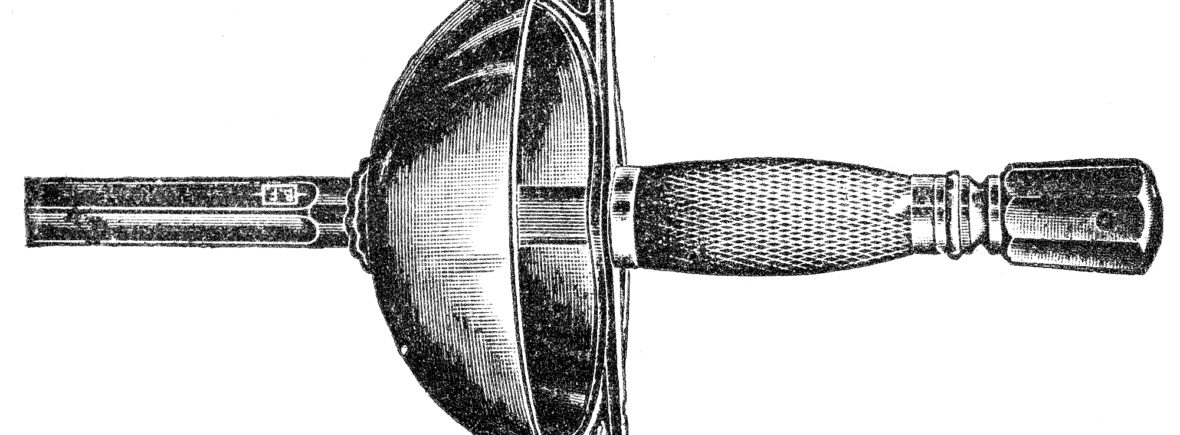Italian Fencing Sword Glossary
A glossary of Italian fencing sword components including those from the the foil (or fioretto) and the dueling sword (or spada).
Italian Fencing Sword Blade
 Blade: The blade of an Italian fencing weapon is made of a spring steel meaning it yields when bent. Italians preferred either rectangular or diamond cross-sectioned blades their training foils and dueling swords. The blade has a tang, often threaded, which passes through the other weapon components holding the hilt together.
Blade: The blade of an Italian fencing weapon is made of a spring steel meaning it yields when bent. Italians preferred either rectangular or diamond cross-sectioned blades their training foils and dueling swords. The blade has a tang, often threaded, which passes through the other weapon components holding the hilt together.
Button: The button is the covering over a blunted blade’s point. The purpose of the button is to slightly cushion and broaden the point’s impact for safe practice. Buttons were traditionally made of leather and cord, though recently have been made of metal and plastic.
Point: The point is the uncovered end of a weapon’s blade. On dueling weapons the point would be needle sharp, though for training they’re blunted by either rolling the point or flattening it into a nail head and covered it with a button.
Foible, Middle & Forte: The blade is generally divided into three parts for training purposes: the debole or ‘weak’ (last 1/3), the middle, and the forte or ‘strong’ (1/3rd closest to the guard)
Curve (Blade): The curve of the blade refers to the gentle downward bend given to the blade in order to suggest the flex in a regular direction. Regular bending in one direction helps prolong the life of the blade.
Cuff: The cuff is the ricasso’s topmost rim on a fixed ricasso blade.
Ricasso: A visible portion of the blade directly manipulated by the hand. A blade can have either a fixed or variable ricasso. A fixed ricasso is fabricated to a definite length via a rim called a cuff. A variable ricasso is so named because there is no cuff, and the hilt components used (quillion block, arches, hands & guard) will determine the length of the visible ricasso.
Ricasso (false): A false ricasso is a separate component designed to imitate a ricasso on the neck of the tang.
Shoulder: The junction between the blade and the tang that rests against the crossbar. This is also sometimes referred to as the heel.
Neck: The neck is the portion of the tang, often only the first one or two inches from the shoulder, that is made square. This square architecture is critical for a grip to fit securely and prevent rotation.
Italian Fencing Sword Hilt
Rosette: A rosette is a metal element in front of the guard that’s either decorative or structurally supportive. Rosettes may be held in place by either stacking on the tang or by riveting directly onto the guard.
Guard: Guards sit immediately behind the blade providing protection for the hand and act as a fulcrum for deflecting opposing weapons; guards act as the shield. The guards on Italian weapons are riveted, soldered, or screwed onto the crossbar’s hands.
Guard Assembly: A guard assembly is a guard with which more than one component is required to be considered whole. A guard assembly typically includes a guard and a crossbar.
Crossbar: A short name for a transverse bar set perpendicular to the blade. The length of the crossbar is often set slightly protruding beyond the guard or flush with it.
Arches: The extended supports on a crossbar that reach to and connect the guard via the hands.
Hands: The flattened connection points where the guard secures to the arches. Often done with rivets, soldering or screws.
Quillions: The protruding ends of the crossbar of variable length.
Quillion Block: The center of the crossbar through which the tang passes.
Hilt: The hilt is the combination of components making up the manipulated and protective portions of the weapon including the guard, pad, grip & pommel.
Pad: A leather or cushioned cloth pad behind the guard designed to cushion the fingers if impacted against the guard.
Grip: The grip is how a swordsperson manipulates the weapon. There are varieties of grip styles, shapes and materials depending on the school of fencing and individual preference. Grips are designed to be comfortable, but above all facilitate the manipulation of the weapon the way it was designed to handle.
Pommel: Pommels hold all the weapon’s components together by threading onto the tang balance the weapon backward. Pommels were historically peened to the tang, though are threaded today for easy dismounting.
Tang Channel: The tang channel (or aperture; perforation) is the hole in all the hilt components through which the tang passes and secures with the pommel.


